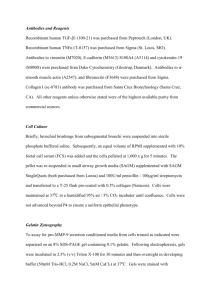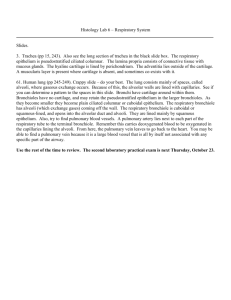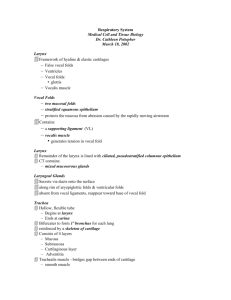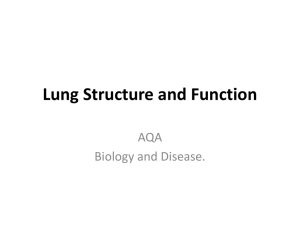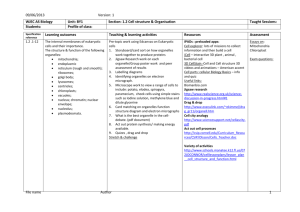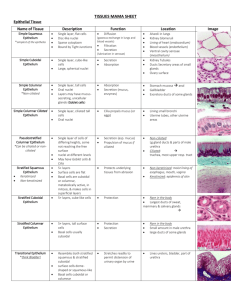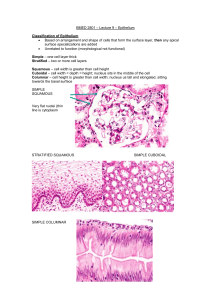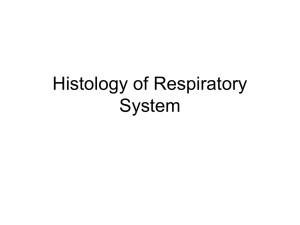Lab 4 Handout
advertisement
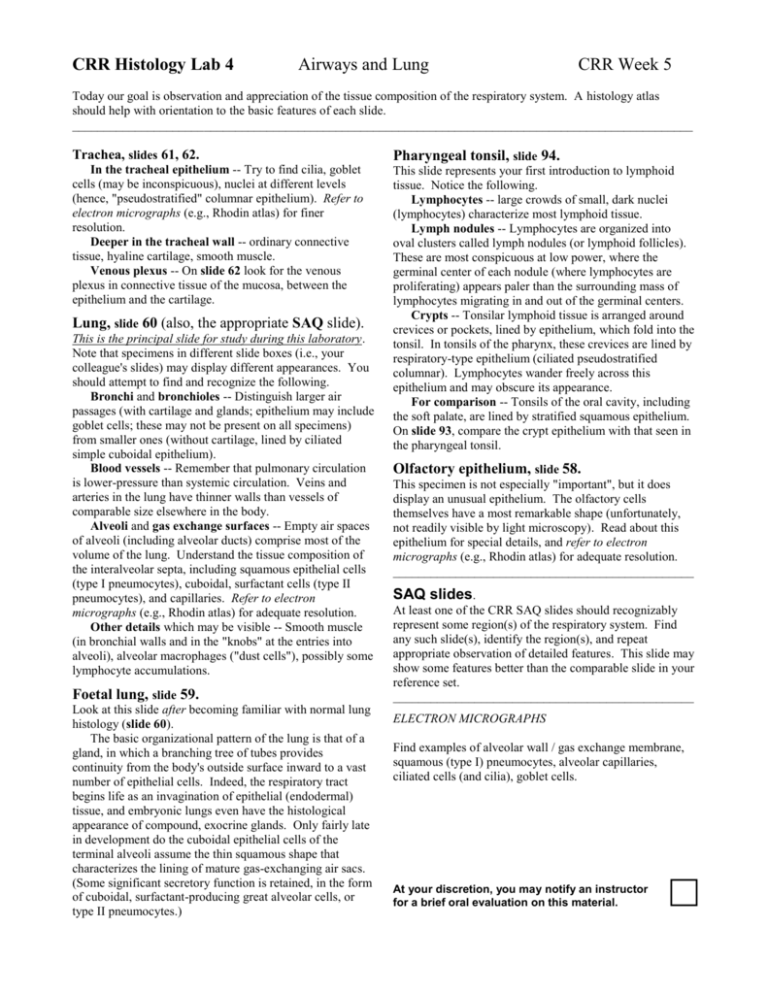
CRR Histology Lab 4 Airways and Lung CRR Week 5 Today our goal is observation and appreciation of the tissue composition of the respiratory system. A histology atlas should help with orientation to the basic features of each slide. ___________________________________________________________________________________________________ Trachea, slides 61, 62. Pharyngeal tonsil, slide 94. In the tracheal epithelium -- Try to find cilia, goblet cells (may be inconspicuous), nuclei at different levels (hence, "pseudostratified" columnar epithelium). Refer to electron micrographs (e.g., Rhodin atlas) for finer resolution. Deeper in the tracheal wall -- ordinary connective tissue, hyaline cartilage, smooth muscle. Venous plexus -- On slide 62 look for the venous plexus in connective tissue of the mucosa, between the epithelium and the cartilage. This slide represents your first introduction to lymphoid tissue. Notice the following. Lymphocytes -- large crowds of small, dark nuclei (lymphocytes) characterize most lymphoid tissue. Lymph nodules -- Lymphocytes are organized into oval clusters called lymph nodules (or lymphoid follicles). These are most conspicuous at low power, where the germinal center of each nodule (where lymphocytes are proliferating) appears paler than the surrounding mass of lymphocytes migrating in and out of the germinal centers. Crypts -- Tonsilar lymphoid tissue is arranged around crevices or pockets, lined by epithelium, which fold into the tonsil. In tonsils of the pharynx, these crevices are lined by respiratory-type epithelium (ciliated pseudostratified columnar). Lymphocytes wander freely across this epithelium and may obscure its appearance. For comparison -- Tonsils of the oral cavity, including the soft palate, are lined by stratified squamous epithelium. On slide 93, compare the crypt epithelium with that seen in the pharyngeal tonsil. Lung, slide 60 (also, the appropriate SAQ slide). This is the principal slide for study during this laboratory. Note that specimens in different slide boxes (i.e., your colleague's slides) may display different appearances. You should attempt to find and recognize the following. Bronchi and bronchioles -- Distinguish larger air passages (with cartilage and glands; epithelium may include goblet cells; these may not be present on all specimens) from smaller ones (without cartilage, lined by ciliated simple cuboidal epithelium). Blood vessels -- Remember that pulmonary circulation is lower-pressure than systemic circulation. Veins and arteries in the lung have thinner walls than vessels of comparable size elsewhere in the body. Alveoli and gas exchange surfaces -- Empty air spaces of alveoli (including alveolar ducts) comprise most of the volume of the lung. Understand the tissue composition of the interalveolar septa, including squamous epithelial cells (type I pneumocytes), cuboidal, surfactant cells (type II pneumocytes), and capillaries. Refer to electron micrographs (e.g., Rhodin atlas) for adequate resolution. Other details which may be visible -- Smooth muscle (in bronchial walls and in the "knobs" at the entries into alveoli), alveolar macrophages ("dust cells"), possibly some lymphocyte accumulations. Foetal lung, slide 59. Look at this slide after becoming familiar with normal lung histology (slide 60). The basic organizational pattern of the lung is that of a gland, in which a branching tree of tubes provides continuity from the body's outside surface inward to a vast number of epithelial cells. Indeed, the respiratory tract begins life as an invagination of epithelial (endodermal) tissue, and embryonic lungs even have the histological appearance of compound, exocrine glands. Only fairly late in development do the cuboidal epithelial cells of the terminal alveoli assume the thin squamous shape that characterizes the lining of mature gas-exchanging air sacs. (Some significant secretory function is retained, in the form of cuboidal, surfactant-producing great alveolar cells, or type II pneumocytes.) Olfactory epithelium, slide 58. This specimen is not especially "important", but it does display an unusual epithelium. The olfactory cells themselves have a most remarkable shape (unfortunately, not readily visible by light microscopy). Read about this epithelium for special details, and refer to electron micrographs (e.g., Rhodin atlas) for adequate resolution. ________________________________________________ SAQ slides. At least one of the CRR SAQ slides should recognizably represent some region(s) of the respiratory system. Find any such slide(s), identify the region(s), and repeat appropriate observation of detailed features. This slide may show some features better than the comparable slide in your reference set. ________________________________________________ ELECTRON MICROGRAPHS Find examples of alveolar wall / gas exchange membrane, squamous (type I) pneumocytes, alveolar capillaries, ciliated cells (and cilia), goblet cells. At your discretion, you may notify an instructor for a brief oral evaluation on this material. □

